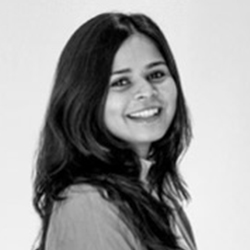
Ria Sheth (MES ’20) was finishing up a structural engineering undergraduate degree in her hometown of Mumbai, India, when she took her first green buildings class as an elective. Environmentally-conscious living had always been part of her life in small ways. “My mother used to scold me if I left the light on in a room—little things like that,” she says, “but I didn't realize how much a part of me sustainability was until I took that course. It was the first time I realized I could take my career down an environmental path.” Inspired, Ria looked for a master’s degree that would help her refine a sustainability focus for her professional pursuits and chose Penn’s Master of Environmental Studies (MES) program.
“I picked the Penn MES because the coursework was interdisciplinary and because I could learn about sustainability at various scales,” she says. In addition to the large-scale environmental impact of green buildings, she was also interested in how a single product could be made sustainable. “A friend and I started a pajama company our sophomore year in college,” she explains. “We wanted to do something fun that wasn’t related to work or school.” Together they designed custom sleepwear for Majama Pajama in their spare time, planning to continue to grow the enterprise alongside full-time careers. “So when I was looking at graduate programs,” Ria says, “I also wanted something that would help that business.”

Ria started the MES program in 2018 intending to pursue the environmental sustainability concentration. In spite of her motivation, she struggled with the theoretical courses she took her first semester. “I wanted something that was a little more practical because I am an engineer. I was used to calculations and hands-on learning and I was worried I made a mistake,” she says. Ria took her concerns to the program director, Dr. Yvette Bordeaux. “I poured my heart out,” she remembers. “I told Yvette about my confusion and how I wondered if I should even be in the program.” Yvette reassured her and reminded Ria that the program was designed to be flexible; she could develop an individualized concentration to meet her goals by including relevant courses from schools across Penn—including the Weitzman School of Design—into her curriculum. “That conversation was a highlight for me at Penn,” she says. “I was encouraged to follow my interest in sustainable design and take classes that were more technical and design focused.” Ria supplemented her environmental studies courses with Penn Design and business courses to build her customized sustainable design curriculum.
The selections she made for her concentration would be some of the most relevant coursework for her future career. In Ecology, Technology, and Design, the class performed a carbon analysis of the White House. “The foundations I learned in that course are things that I use at my job today,” she says. In Life Cycle Assessment (LCA), she learned how to perform a thorough and systematic analysis of a single product to measure its lifetime impact in numerous environmental categories. “I don’t think I could have jumped into LCAs for whole buildings during my career if I hadn’t taken that class,” she says.
Another pivotal opportunity for Ria was studying for and earning the LEED Green Associate credential, thanks to a non-credit prep course the MES program offered. LEED (Leadership in Energy and Environmental Design) is an internationally-recognized standard for certifying green buildings, and the Green Associate credential denotes proficiency in those standards—a valuable credential for any green building professional. Beyond carbon footprints and the lifetime environmental impact of buildings, the prep course also covered additional evaluation topics Ria was not yet familiar with, like location and availability of transportation and services for occupants. The experience helped solidify Ria’s career goals and guide her remaining curriculum choices. “After the LEED exam I was sure that I wanted to pursue a career in green buildings and getting buildings certified,” she says.
In her last semester, Ria interned with the Virginia-based sustainability consultancy Above Green as a sustainability engineer while working on her capstone project—the culminating requirement for her degree. “I wanted to intern in the United States before I actually went out and got a job to have a better idea of what to expect. And the company was willing to help me with my capstone project as part of my internship—it was everything that I wanted,” she says. Her project involved researching and comparing the green building policies and interventions of San Francisco, Boston, and New York. “I looked at where each city planned to be in 30 years and I did some calculations to gauge whether they were on track or not to achieve that target and give recommendations accordingly.” Her findings were shared at several green building conferences. In addition to completing her capstone, she also gained her first real-life experience in green building certifications at Above Green. “We got a building that I was working on LEED Gold certified,” she shares.
After graduation, Ria worked for SustainAble Production in Los Angeles, certifying buildings for the WELL Building Standard. “LEED focuses more on greening the whole design and construction process,” Ria says, “but WELL focuses more on the human occupants and whether they feel safe and comfortable and healthy in your environment.” She has since gained her WELL Accredited Professional certification to complement her LEED GA.
Today Ria is doing what she loves as a design staff member at Atelier Ten, environmental design consultants and engineers based in New York City. One of her current projects involves making design recommendations focused on patient comfort for a hospital complex in Virginia. Another is an LCA for the American Institute of Architects headquarters in Washington, DC, comparing retrofitting and restoration options to demolition and rebuilding. “I'm really happy that I'm actually doing what I'm passionate about,” she says.
As for Majama Pajama, Ria and her co-founder are slowly working toward making it a more sustainable business by incorporating lessons Ria learned at Penn. “In the LCA course, I compared the sustainability of silk to cotton because it could help with the pajama company,” she says. She discovered that silk was more sustainable than cotton, but organic cotton farmed in a sustainable manner won over silk. “We try to use as many sustainable fabrics as possible and we’re working to optimize the whole process.”
After her rough start to the MES, Ria is glad she received the encouragement to persevere and the support to build an individualized concentration. “Penn has been the best experience I’ve had so far,” she says. “I put myself out there and I've evolved as a person through the MES. I know what I want so much more than I did when I was comfortable in my own bubble,” she says. She hopes other students will get out of their comfort zones, too. “There’s so much the program has to offer that you’ll probably find you’re interested in something you didn’t expect,” she advises. “You’ll find your calling.”





